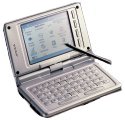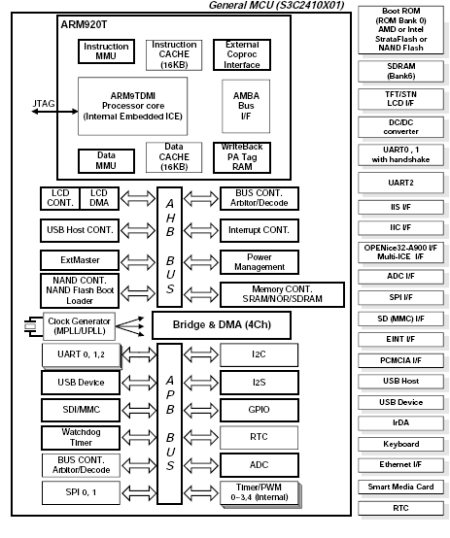Linux special effects kit targets ARM9 dev board
Sep 23, 2005 — by LinuxDevices Staff — from the LinuxDevices Archive — 9 views An Australian company that in June ported its consumer device user interface development kit to Linux/Qtopia has now targeted its first development board. Fluffy Spider Technologies (FST) says its FancyPants graphics platform supports Aiji Systems's SMDK2410 board for Samsung's S3C2410X01, a 16/32-bit… ARM920T-based SoC (system-on-chip) targeting handheld and consumer devices.
An Australian company that in June ported its consumer device user interface development kit to Linux/Qtopia has now targeted its first development board. Fluffy Spider Technologies (FST) says its FancyPants graphics platform supports Aiji Systems's SMDK2410 board for Samsung's S3C2410X01, a 16/32-bit… ARM920T-based SoC (system-on-chip) targeting handheld and consumer devices.
(Click for slightly larger view of SMDK2410 dev board)
Samsung S3C2410X chip, and Aiji SMDK2410 board
 Samsung's S3C2410X processor was used recently in Unication's Linux-powered Magpie PDA (pictured at right), and has been marketed by Samsung in a “System-in-Package” format combining processor, Flash, and SDRAM, and targeting mobile phones.
Samsung's S3C2410X processor was used recently in Unication's Linux-powered Magpie PDA (pictured at right), and has been marketed by Samsung in a “System-in-Package” format combining processor, Flash, and SDRAM, and targeting mobile phones.
The SMDK2410 development board includes 8MB of AMD boot Flash, 16MB of Intel StrataFlash, and 64MB of Sansung NAND Flash, along with 64MB of SDRAM. Interfaces include TFT/STN LCD/touch panel, three UART (including IrDA), two USB ports, SD/MMC interface, smart media card interface, JTAG port, RTC X-tal input logic, I2C, ADC, SPI, EINT, Ethernet, PCMCIA, and an LED disply for debugging.

The SMDK2410 includes all kinds of mobile device I/O
Korean Linux specialist Mizi Research, which helped Samsung develop its Linux-based SCH-i519 mobile phone, offers a GPL'd Linux BSP (board support package) for the SMDK2410 board.
FancyPants
FST says its FancyPants lightweight graphics software allows limited-resource devices to deliver rich multimedia experiences. On the SMDK2410 board, its “FastRender” technology can deliver full-screen, 25fps video during CD-quality audio playback, the company says.
Special effects supported by FancyPants include skinning, overlays, and fancy effects, and targets media-centric consumer and mobile devices, such as POS (point-of-sales/service) systems, set-top boxes, and mobile phones. According to FST, FancyPants requires less that 3MB of disk space, yet can apply sophisticated special effects over on-screen elements, including still images and running video. Effects include soft shadows, screen and image transitions, fades and wipes, 32-bit alpha blending, animations, glitter, color manipulation, scaling, rotation, 3D folds, and more.
FST's managing director, Robi Karp, said, “Formal support for the [SMDK2410] board allows developers to quickly experiment. We have already seen a number of new applications, since we started testing on the board, and are looking forward to helping current and future clients in experiencing the power of FancyPants on the ARM processor.”
Availability
FancyPants is available now, with support for Linux, Linux/Qtopia, Symbian UIQ, and Windows CE. It supports ARM9, ARM11, XScale, and x86.
This article was originally published on LinuxDevices.com and has been donated to the open source community by QuinStreet Inc. Please visit LinuxToday.com for up-to-date news and articles about Linux and open source.